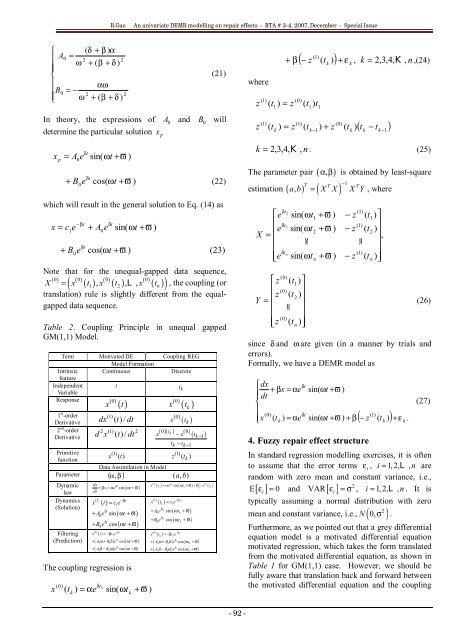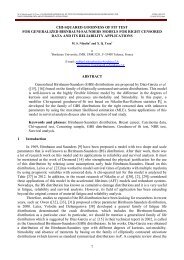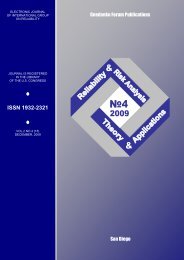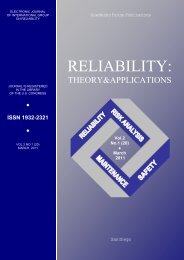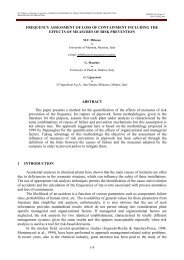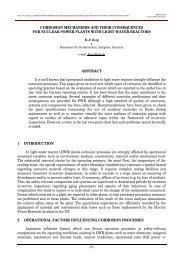R.GuoAn univariate DEMR modell<strong>in</strong>g on repair effects - RTA # 3-4, 2007, December - Special Issue⎧ ( δ + β ) α⎪ A0=22⎪ω + ( β + δ )⎨⎪αω⎪B0= −2⎩ ω + ( β + δ )2(21)In theory, the expressions of A0and B0willdeterm<strong>in</strong>e the particular solutionxpδt= A0es<strong>in</strong>( ωt+ ϖ )x pδ+ B et cos( ωt+ )(22)0ϖwhich will result <strong>in</strong> the general solution to Eq. (14) as−βtδtx = c1e+ A0es<strong>in</strong>( ωt+ ϖ )δ+ B et cos( ωt+ )(23)0ϖNote that for the unequal-gapped data sequence,( ) ( ) (( ) ) (X 0 = ( x 0 t 0 ( ) 0)1 , x t2, L , x ( tn)), the coupl<strong>in</strong>g (ortranslation) rule is slightly different from the equalgappeddata sequence.Table 2. Coupl<strong>in</strong>g Pr<strong>in</strong>ciple <strong>in</strong> unequal gappedGM(1,1) Model.Term Motivated DE Coupl<strong>in</strong>g REGModel FormationIntr<strong>in</strong>sic Cont<strong>in</strong>uousDiscretefeatureIndependenttVariablet kResponse ( 0x) ( t)1 st -orderDerivative2 nd -orderDerivativePrimitivefunction( 0x ) ( t k )dx (1) ( t)/dt ( 0 ) ( )x t k0 02 (1) 2d x ( t)/dt x( )( ) − x( ) ( t )x(1) () tParameter ( )DynamiclawDynamics(Solution)Filter<strong>in</strong>g(Prediction)t ktk− tk−1(1) ( ) z t kData Assimilation <strong>in</strong> Modelα, β( a,b)dxδt+β x =αe s<strong>in</strong>( ω t+ϖ)dt( 1 ) ( )δt0δt0−βt1x t = ce( t )( t )+ A e s<strong>in</strong> ω +ϖ+ B e cos ω +ϖ( 0 ) −βtx ( t)= −βce1δt+ ( A0ω+ B0δ) e cos( ω t+ϖ)δt+ ( A δ−B ω) e s<strong>in</strong>( ω t+ϖ)0 0The coupl<strong>in</strong>g regression isx(0)( tk)=kα δ tke s<strong>in</strong>( ωt+ ϖ )k −1( )( 0x )( tk) =αe ( 1s<strong>in</strong>( ω t ) )k+ϖ +β −z ( tk)δt k( 1 ) ( )kδtk0δtk0−βtk1x t = ce( tk)( t )+ A e s<strong>in</strong> ω +ϖ+ B e cos ω +ϖ( 0 ) −βt x ( t )kk = −βce1δt+ ( A0ω+ B0δ) e cos( ω tk+ϖ)δt+ ( A δ−B ω) e s<strong>in</strong>( ω t +ϖ)0 0kkwherez =z(1)( −z( )) ε ,+ β + k = 2,3,4,K,n ,(24)(1)(0)( t1)z ( t1)t1t kk( t − t )(1)(1)(0)( tk) = z ( tk−1) + z ( tk)k k −1k = 2,3,4,K,n . (25)The parameter pair ( αβ , ) is obta<strong>in</strong>ed by least-squareestimation ( , ) ( ) −1⎡e⎢⎢eX =⎢⎢⎢⎣e⎡z⎢⎢zY =⎢⎢⎢⎣zδt2δt3δtn(0)(0)(0)T T Ta b = X X X Y , wheres<strong>in</strong>( ωts<strong>in</strong>( ωtMs<strong>in</strong>( ωt( t( tM(12t n) ⎤⎥) ⎥⎥⎥) ⎥⎦12n+ ϖ )+ ϖ )+ ϖ )− z− z− z(1)(1)M(1)( t( t( t12n) ⎤⎥) ⎥,⎥⎥) ⎥⎦(26)s<strong>in</strong>ce δ and ω are given (<strong>in</strong> a manner by trials anderrors).Formally, we have a DEMR model as⎧dx⎪ + βx= αedt⎨⎪(0)⎪⎩x ( tk) = αeδtδts<strong>in</strong>( ωt+ ϖ )s<strong>in</strong>( ωt+ ϖ ) + β4. Fuzzy repair effect structure(1)( − z ( t ))k+ ε .k(27)In standard regression modell<strong>in</strong>g exercises, it is oftento assume that the error terms εi, i= 1,2, L , n arerandom with zero mean and constant variance, i.e.,2E ε = 0 and VAR [ ε ] =σ , i= 1,2, L , n. It is[ ]iitypically assum<strong>in</strong>g a normal distribution with zero2mean and constant variance, i.e., ( 0, )N σ .Furthermore, as we po<strong>in</strong>ted out that a grey differentialequation model is a motivated differential equationmotivated regression, which takes the form translatedfrom the motivated differential equation, as shown <strong>in</strong>Table 1 for GM(1,1) case. However, we should befully aware that translation back and forward betweenthe motivated differential equation and the coupl<strong>in</strong>g- 92 -
R.GuoAn univariate DEMR modell<strong>in</strong>g on repair effects - RTA # 3-4, 2007, December - Special Issueregression will br<strong>in</strong>g <strong>in</strong> new error which is different2from the random sampl<strong>in</strong>g error ( 0, )N σ . The errorsbrought <strong>in</strong> come from the steps of the usage of0 1 1difference x k = x k −x k −1to replace the( )( )derivative ( dx dt ) t = k( )( )accumulated partial sum( )( )and the usage of the average( )( )( 1 )( )z t to replace the1primitive function x tkdur<strong>in</strong>g the translationbetween the motivated differential equation and thecoupl<strong>in</strong>g regression.Our simulation studies have shown that the coupl<strong>in</strong>g<strong>in</strong>troducederror is dependent upon the grids size ∆ , orequivalent to the total number of approximation N.The simulation evidences have shown that the largerthe number of approximat<strong>in</strong>g grid, or equivalently, thesmaller the approximat<strong>in</strong>g grid, the coupl<strong>in</strong>gtranslation error is smaller. However, the coupl<strong>in</strong>gtranslation error and the approximat<strong>in</strong>g grid do nothold a determ<strong>in</strong>istic functional relation. What we cansee is the functional relation has a certa<strong>in</strong> degree ofbelong<strong>in</strong>gness. In other words, the coupl<strong>in</strong>gtranslation process <strong>in</strong>duces a fuzzy error term, denotedas ς with a membership function.We perform a simulation study of the error occurrencecos π 2 byfrequencies of approximat<strong>in</strong>g ( )( s<strong>in</strong> ( π 2) − s<strong>in</strong> ( π 2 +∆x)) ∆ x.frequencyerror's frequency Chart0.60.40.20-1 -0.5 -0.2 0 0.5 1errorFigure 1. Error occurrence frequencyTherefore, <strong>in</strong> general the error terms of a differentialequation motivated regression model (i.e., greydifferential equation <strong>in</strong> current grey theory literature)is fuzzy because the vague nature of the erroroccurrences.As a standard exercise, the fuzzy error componentmay be assumed as triangular fuzzy variable with amembership functionkei⎧s+ o if − o ≤ s < 0⎪⎪o⎪o− s if 0 ≤ s ≤ oµe( s)= ⎨(28)⎪ o⎪⎪0otherwise⎩which has a fuzzy mean zero.However, <strong>in</strong> the modell<strong>in</strong>g of system function<strong>in</strong>gtimes, we further note that the repair will reset thesystem dynamic rule so that the repair impact may beunderstood as a fuzzy variable hav<strong>in</strong>g a triangularmembership⎧ z − a⎪if a ≤ z < bb − a⎪c− zµr( z)= ⎨if b ≤ z < c (29)⎪c− b⎪0otherwise⎪⎩The fuzzy mean of the fuzzy repair effect is thus1Eµ( r)= ( a + 2b+ c), (30)4which provides a repair effect structure. Therefore, the“composite” fuzzy “error” term appear<strong>in</strong>g <strong>in</strong> thedifferential equation motivated regression formodell<strong>in</strong>g a system function time will beζi= e + r ,iii = 2,3,K,n , (31)with a triangular membership function, i.e.,⎧w− a + ϖ⎪if a −ϖ≤ w < bb − a + ϖ⎪c+ ϖ − wµ ζ ( w)= ⎨if b ≤ w < c + ϖ (32)⎪ c + ϖ − b⎪0otherwise⎪⎩because the sum of two triangular fuzzy variables isstill a triangular fuzzy variable. The total errorξ = ζ + ε = r + e ) + ε , i = 2,3,K,n , (33)iii(i i iwhich is a sequence of random fuzzy variablesbecause the summation nature of a random fuzzyvariable and a fuzzy variable accord<strong>in</strong>g to Liu [5].Now, we reach a po<strong>in</strong>t that the random fuzzy variableconcept is <strong>in</strong>volved and therefore it is necessary to- 93 -
- Page 1 and 2:
ISSN 1932-2321RELIABILITY:Theory &
- Page 5 and 6:
e‐journal “Reliability: Theory&
- Page 7:
e‐journal “Reliability: Theory&
- Page 10 and 11:
A.Blokus-Roszkowska Analysis of com
- Page 12:
A.Blokus-Roszkowska Analysis of com
- Page 20 and 21:
R. Bri Stochastic ageing models - e
- Page 22 and 23:
R. Bri Stochastic ageing models - e
- Page 24 and 25:
R. Bri Stochastic ageing models - e
- Page 26 and 27:
R. Bri Stochastic ageing models - e
- Page 28 and 29:
T.BudnyTwo various approaches to VT
- Page 30 and 31:
T.BudnyTwo various approaches to VT
- Page 32 and 33:
T.BudnyTwo various approaches to VT
- Page 34 and 35:
J.Duarte, C.Soares Optimisation of
- Page 36 and 37:
J.Duarte, C.Soares Optimisation of
- Page 38 and 39:
J.Duarte, C.Soares Optimisation of
- Page 40 and 41:
J.Soszyska, P.Dziula, M.Jurdziski,
- Page 42 and 43: J.Soszyska, P.Dziula, M.Jurdziski,
- Page 44 and 45: J.Soszyska, P.Dziula, M.Jurdziski,
- Page 46 and 47: J.Soszyska, P.Dziula, M.Jurdziski,
- Page 48 and 49: J.Soszyska, P.Dziula, M.Jurdziski,
- Page 50 and 51: J.Soszyska, P.Dziula, M.Jurdziski,
- Page 52 and 53: J.Soszyska, P.Dziula, M.Jurdziski,
- Page 54 and 55: M.Elleuch, B.Ben, F.MasmoudiImprove
- Page 56 and 57: M.Elleuch, B.Ben, F.MasmoudiImprove
- Page 58 and 59: M.Elleuch, B.Ben, F.MasmoudiImprove
- Page 60 and 61: F.GrabskiApplications of semi-Marko
- Page 62 and 63: F.GrabskiApplications of semi-Marko
- Page 64 and 65: F.GrabskiApplications of semi-Marko
- Page 66 and 67: F.GrabskiApplications of semi-Marko
- Page 68 and 69: F.GrabskiApplications of semi-Marko
- Page 70 and 71: F.GrabskiApplications of semi-Marko
- Page 72 and 73: F.GrabskiApplications of semi-Marko
- Page 74 and 75: F.GrabskiApplications of semi-Marko
- Page 76 and 77: F.Grabski The random failure rate -
- Page 78 and 79: F.Grabski The random failure rate -
- Page 80 and 81: F.Grabski The random failure rate -
- Page 82 and 83: F.Grabski The random failure rate -
- Page 84 and 85: F.Grabski, A. Zaska-FornalThe model
- Page 86 and 87: F.Grabski, A. Zaska-FornalThe model
- Page 88 and 89: F.Grabski, A. Zaska-FornalThe model
- Page 90 and 91: R.GuoAn univariate DEMR modelling o
- Page 94 and 95: R.GuoAn univariate DEMR modelling o
- Page 96 and 97: R.GuoAn univariate DEMR modelling o
- Page 98 and 99: S.Guze Numerical approach to reliab
- Page 100 and 101: S.Guze Numerical approach to reliab
- Page 102 and 103: S.Guze Numerical approach to reliab
- Page 104 and 105: S.Guze, K.Koowrocki Reliability ana
- Page 106 and 107: S.Guze, K.Koowrocki Reliability ana
- Page 108 and 109: S.Guze, K.Koowrocki Reliability ana
- Page 110 and 111: S.Guze, K.Koowrocki Reliability ana
- Page 112 and 113: L.Knopik Some remarks on mean time
- Page 114 and 115: L.Knopik Some remarks on mean time
- Page 116 and 117: K.Koowrocki Reliability modelling o
- Page 118 and 119: K.Koowrocki Reliability modelling o
- Page 120 and 121: K.Koowrocki Reliability modelling o
- Page 122 and 123: K.Koowrocki Reliability modelling o
- Page 124 and 125: K.Koowrocki Reliability modelling o
- Page 126 and 127: K.Koowrocki Reliability modelling o
- Page 128 and 129: K.Koowrocki Reliability modelling o
- Page 130 and 131: K.Koowrocki Reliability modelling o
- Page 132 and 133: K.Koowrocki Reliability modelling o
- Page 134 and 135: K.Koowrocki Reliability modelling o
- Page 136 and 137: K.Koowrocki Reliability modelling o
- Page 138 and 139: K.Koowrocki Reliability modelling o
- Page 140 and 141: A. Kudzys Transformed conditional p
- Page 142 and 143:
A. Kudzys Transformed conditional p
- Page 144 and 145:
A. Kudzys Transformed conditional p
- Page 146 and 147:
A. Kudzys Transformed conditional p
- Page 148 and 149:
B. Kwiatuszewska-Sarnecka On asympt
- Page 150 and 151:
B. Kwiatuszewska-Sarnecka On asympt
- Page 152 and 153:
B. Kwiatuszewska-Sarnecka On asympt
- Page 154 and 155:
B. Kwiatuszewska-Sarnecka On asympt
- Page 156 and 157:
B. Kwiatuszewska-Sarnecka On asympt
- Page 158 and 159:
B. Kwiatuszewska-Sarnecka On asympt
- Page 160 and 161:
B. Kwiatuszewska-Sarnecka On asympt
- Page 162 and 163:
B. Kwiatuszewska-Sarnecka On asympt
- Page 164 and 165:
B. Kwiatuszewska-Sarnecka On asympt
- Page 166 and 167:
B. Kwiatuszewska-Sarnecka On asympt
- Page 168 and 169:
B. Kwiatuszewska-Sarnecka On asympt
- Page 170 and 171:
B. Kwiatuszewska-Sarnecka On asympt
- Page 172 and 173:
U. Rakowsky Fundamentals of the Dem
- Page 174 and 175:
U. Rakowsky Fundamentals of the Dem
- Page 176 and 177:
U. Rakowsky Fundamentals of the Dem
- Page 178 and 179:
U. Rakowsky Fundamentals of the Dem
- Page 180 and 181:
U. Rakowsky Fundamentals of the Dem
- Page 182 and 183:
U. Rakowsky Fundamentals of the Dem
- Page 184 and 185:
J. Soszyska Systems reliability ana
- Page 186 and 187:
J. Soszyska Systems reliability ana
- Page 188 and 189:
J. Soszyska Systems reliability ana
- Page 190 and 191:
J. Soszyska Systems reliability ana
- Page 192 and 193:
J. Soszyska Systems reliability ana
- Page 194 and 195:
J. Soszyska Systems reliability ana
- Page 196 and 197:
D. Vali Reliability of complex syst
- Page 198 and 199:
D. Vali Reliability of complex syst
- Page 200 and 201:
D. Vali Reliability of complex syst
- Page 202 and 203:
D. Vali Reliability of complex syst
- Page 204 and 205:
E. Zio Soft computing methods appli
- Page 206 and 207:
E. Zio Soft computing methods appli
- Page 208 and 209:
E. Zio Soft computing methods appli
- Page 210 and 211:
E. Zio Soft computing methods appli
- Page 212 and 213:
E. Zio Soft computing methods appli
- Page 214 and 215:
E. Zio Soft computing methods appli
- Page 216 and 217:
E. Zio Soft computing methods appli
- Page 218 and 219:
E. Zio Soft computing methods appli
- Page 220 and 221:
E.Zio, P.Baraldi, I.Popescu Optimiz
- Page 222 and 223:
E.Zio, P.Baraldi, I.Popescu Optimiz
- Page 224 and 225:
E.Zio, P.Baraldi, I.Popescu Optimiz
- Page 226 and 227:
E.Zio, P.Baraldi, I.Popescu Optimiz
- Page 228 and 229:
E.Zio, P.Baraldi, I.Popescu Optimiz
- Page 230 and 231:
NOTES


